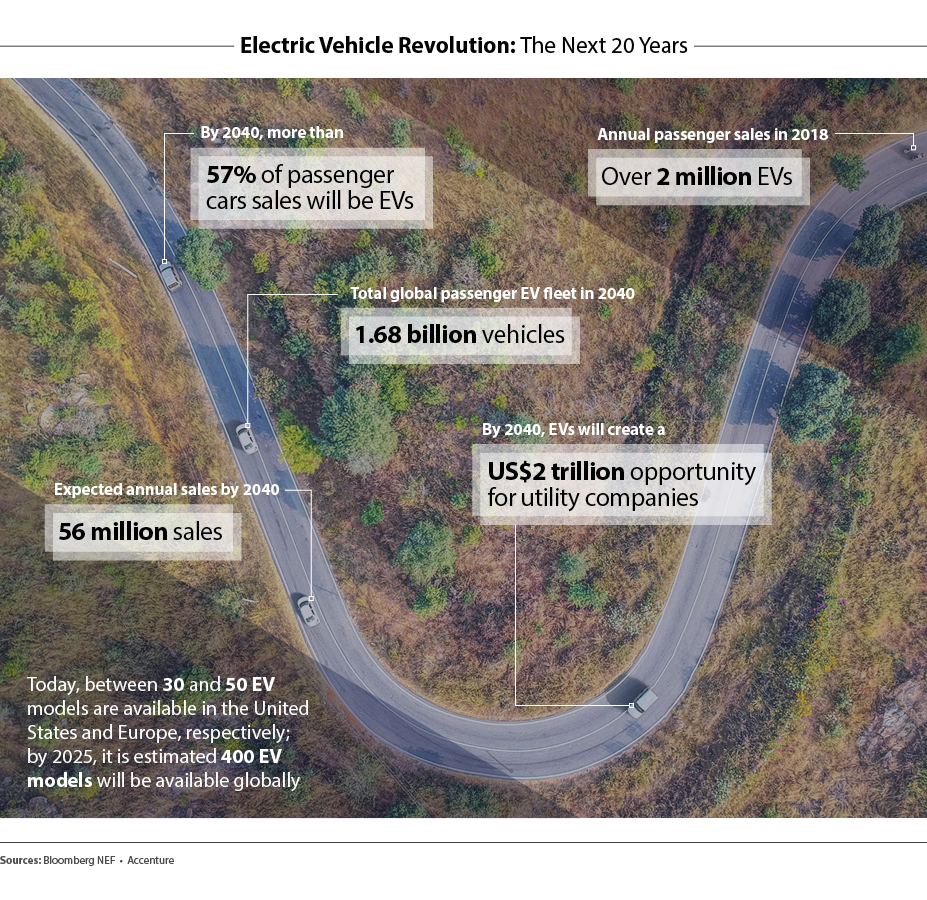By 2040, more than half (57%) of passenger car sales will be electric, while electric buses will completely dominate the market, comprising more than four fifths of sales (81%), according to clean energy analysts BloombergNEF (BNEF). The enthusiasm for a forthcoming electric vehicle (EV) revolution is palpable in many quarters, but practically speaking, it still seems a long way off.
Until now, the main barriers to EV adoption have been drivers’ fear of running out of power, known as ‘range anxiety’, and a limited number of EV models on the market. But Espen Hauge, president of the European Association for Electromobility and also of the Norwegian Electric Vehicle Association, says that these issues are well on the way to being solved, with hundreds of new models coming on to the market over the next few years, with ranges of 200 miles or more.
The next hurdle to be overcome is the lack of charge points. For the market to really take off from here, “we need more charging infrastructure,” says Hauge. “In Norway, which has one of the highest penetrations of EVs, it’s becoming a problem because we’re starting to have a lot more cars on the road. If we don’t have fast charging facilities, there are going to be queues.
“It’s true, we are still very close to the start of the electric vehicle journey,” says Hauge. “But the number of charge points is increasing, car sales are increasing and a number of cities, regions and states are putting targets in place.”
That charging infrastructure is starting to appear thanks to a combination of government incentives and the arrival in the market of several players with the serious financial firepower needed to undertake the necessary investment, including oil majors Shell (which owns New Motion) and BP (Chargemaster), utilities such as Engie (EV Box) and Fortum (Plugsurfing) and carmakers such as BMW and Daimler (Digital Charging Solutions). Earlier this year, Iberdrola announced plans to install 25,000 charge points in Spain by 2021, in an illustration of the scale of the commitments companies are making.

Utilities and network operators have been studying how the growth of the EV market will affect electricity generators for a number of years, says Barry Carruthers, Head of Innovation at Scottish Power. “This is going to be a challenge to regulators and business models in the network sector. We need to invest in the grid.”
EVs also need to be integrated in the context of all the other changes taking place in the energy system, he adds, including electrification of the heating network, the increasing proportion of renewables producing electricity, and the need for a comprehensive charging network, at home, in workplaces and at places where people can charge when they’re out and about. It also needs to be integrated with wider transportation policies encouraging people out of cars altogether and onto public transport.
“Public charging points that are open to everyone will be important, not just on the street but in places like supermarkets, retail parks and leisure centres. We’re starting to roll out publicly available chargers in partnership with local authorities and businesses,” he says.
Although EVs will increase electricity demand, it will not rise by as much as many people think, because EVs are three to four times as efficient as ICEs, Carruthers points out. Even so, the increased load will need to be managed through the use of smart chargers that do not increase the strain on the system at peak times. “We have launched a domestic time-of-use tariff so people can charge cheaply during the night using a smart charger,” he explains.
Another key driver will be the growth of the used car market for the sector, says Carruthers. “The early adopters have had their cars for three to five years and they are starting to buy second-generation vehicles now, so second-hand EVs are coming on to the market. That’s when the tipping point comes, because people don’t need to spend £45,000 to go electric.”
The market is moving so quickly that regulators are struggling to provide the enabling environment the sector needs. “With the rapid price reductions, positive policy and the momentum of the climate emergency, it is no surprise regulation is lagging behind, but if regulators don’t move in a timely fashion, the uptake of EVs will be slower than it could be,” Carruthers adds.
“Electrification will still take time because the global fleet changes slowly,” says Colin McKerracher, head of advanced transport for BNEF, “but, once it gets rolling in the 2020s, it will start to spread to many other areas of road transport. We see a real possibility that worldwide sales of conventional passenger cars have already passed their peak.”






